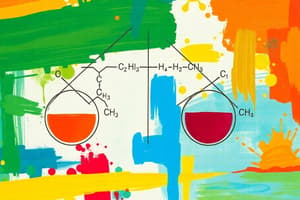Podcast
Questions and Answers
What is the purpose of putting a coefficient in front of sodium hydroxide in a chemical equation?
What is the purpose of putting a coefficient in front of sodium hydroxide in a chemical equation?
- To balance the hydrogen atoms
- To balance the sodium atoms
- To balance the oxygen atoms (correct)
- To balance all elements in the equation
In balancing a chemical equation, why is it important to start with elements like sodium and potassium?
In balancing a chemical equation, why is it important to start with elements like sodium and potassium?
- They occur as single-element molecules (correct)
- They have the highest atomic mass
- They are easy to balance
- They are the most reactive elements
Why is increasing the coefficient of potassium in the equation a simple fix when balancing it?
Why is increasing the coefficient of potassium in the equation a simple fix when balancing it?
- It easily forms bonds
- It is a noble gas
- It reacts vigorously with water
- It occurs as a single atom molecule (correct)
What is the benefit of increasing the coefficient in front of carbon dioxide when balancing carbon in a chemical equation?
What is the benefit of increasing the coefficient in front of carbon dioxide when balancing carbon in a chemical equation?
How does balancing an equation ensure that a chemical reaction is correctly represented?
How does balancing an equation ensure that a chemical reaction is correctly represented?
Why does balancing each atom individually help simplify the overall process of balancing a chemical equation?
Why does balancing each atom individually help simplify the overall process of balancing a chemical equation?
What does adding a coefficient in front of an element aim to achieve in a chemical equation?
What does adding a coefficient in front of an element aim to achieve in a chemical equation?
Why is it crucial to perform a final check after balancing all elements in a chemical equation?
Why is it crucial to perform a final check after balancing all elements in a chemical equation?
What happens if there is an extra molecule of an element on one side of a chemical equation that needs balancing?
What happens if there is an extra molecule of an element on one side of a chemical equation that needs balancing?
In a balanced chemical equation, why should the number of atoms be equal on both sides?
In a balanced chemical equation, why should the number of atoms be equal on both sides?
Flashcards are hidden until you start studying




